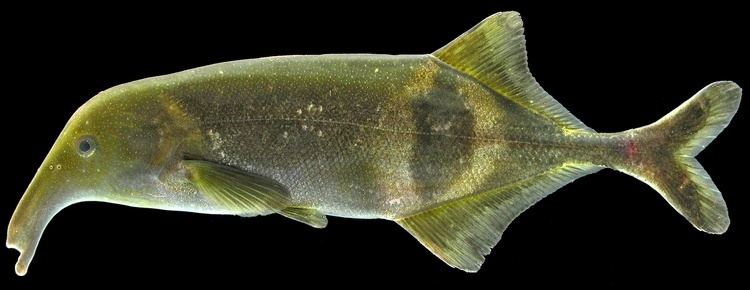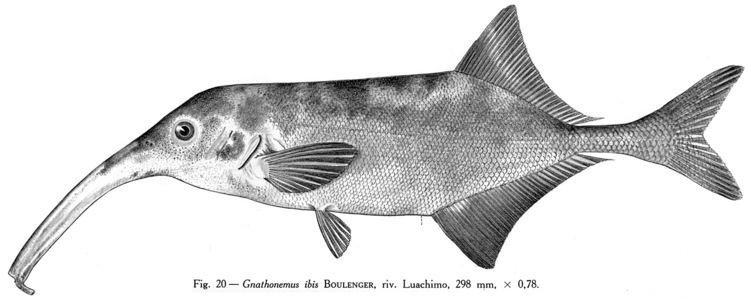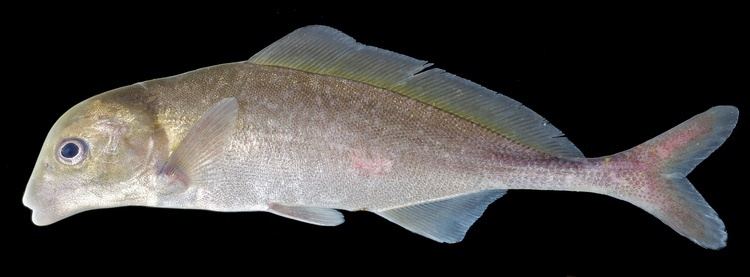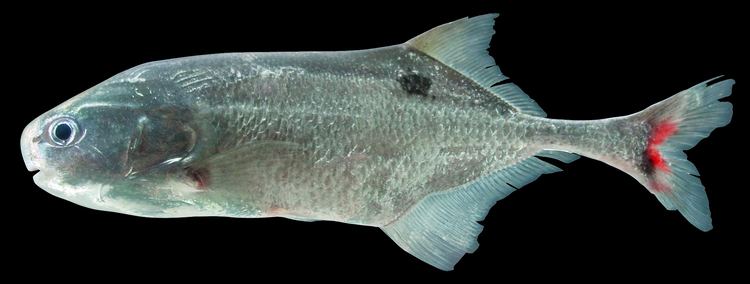Phylum Chordata Rank Family | Scientific name Mormyridae Higher classification Mormyroidea | |
 | ||
Lower classifications | ||
The family Mormyridae, sometimes called "elephantfish" (more properly freshwater elephantfish), are freshwater fish in the order Osteoglossiformes native to Africa. It is by far the largest family in the order with around 200 species. Members of the family can be popular, if challenging, aquarium species. These fish are also known for having large brain size and unusually high intelligence.
Contents

They are not to be confused with the marine and brackish water callorhinchid elephantfish (family Callorhinchidae) of south hemisphere oceans.

Mormyridae 20111108
Description and biology

The elephantfishes are a diverse family, with a wide range of different sizes and shapes. The smallest are just 5 centimetres (2.0 in) in adult length, while the largest reach up to 1.5 metres (4.9 ft). They do, however, have a number of unique features in common. Firstly, the cerebellum (part of the brain) is greatly enlarged, giving them a brain to body size ratio similar to that of humans (though other sources give the brain/body proportion as 'similar to that of birds and marsupials'; Helfman, Collette & Facey 1997, p. 191). This is likely to be related to the interpretation of bio-electrical signals. Secondly, the semicircular canals in the inner ear have an unusual structure and are associated with a gas-filled bladder entirely separate from the main swim bladder.

Some species possess modifications of the mouthparts to facilitate feeding upon small invertebrates buried in muddy substrates. The shape and structure of these leads to the popular name of "elephant nosed fish" for those species with particularly prominent mouth extensions. The extensions to the mouthparts usually consist of a fleshy elongation attached to the lower jaw. They are flexible, and equipped with touch, and possibly taste, sensors. Their mouths are non-protrusible, and their head (including the eyes), the dorsum and belly are covered by a thin layer of skin that is perforated with small pores leading to electroreceptors. The retina of their eyes is called a "grouped retina", a type of eye structure seen in mormyrids and a few other fish. Instead of being smooth, their retina is composed of tiny cups, acting like parabolic mirrors. Because of the murky waters, the cones in their eyes have adapted to see only red light. The cups are made of four layers of light reflecting proteins, funneling red light to areas of cones, intensifying its brightness 10-fold, while the rods are hit by light from other wavelengths. Only a single gonad is present, located on the left side of their body. Mormyridae and their close relative Gymnarchus are also unique in being the only vertebrates where the male sperm cell doesn't have a flagellum.

Among those members of the family lacking extended mouthparts, the body shape and general morphology of the fishes has led to some being known among aquarists by the name of "baby whale", despite the fact that true whales are mammals. Other "mormyrid mammalian misnomers" include the term "dolphin fishes", in reference to certain members of the Genus Mormyrops.
Electric fields

Elephantfishes are notable for their ability to generate weak electric fields that allow the fishes to sense their environment in turbid waters where vision is impaired by suspended matter. The generation of these electric fields and their use in providing the fishes with additional sensory input from the environment is the subject of considerable scientific research, as is research into communication between and within species.
Electric fish can be classified into two types: pulse fish or wave fish. Gymnarchus niloticus is a wave fish, producing a near-sinusoidal discharge of around 500 Hz. The electric discharge is produced from an electric organ that evolved from muscle, as can also be seen in Gymnotiform electric fish, electric rays and skates. The convergent evolution between the South American Gymnotiforms and the African Mormyridae is remarkable, with the electric organ being produced via the substitution of the same amino acid in the same voltage-gated sodium channel despite the two groups of fish being on different continents and the evolution of the electric sense organ being separated in time by around 60 million years.
Classification
There are about 221 species of elephantfish, grouped into two subfamilies, Mormyrinae and Petrocephalinae. The latter has only a single genus:
Family Mormyridae
